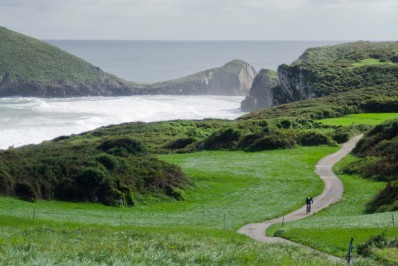Camino del Norte (The Northern Way)
From Irún to Santiago de Compostela. 35 sections. 820 kilometres. It links the last two stages with the French Way. The Camino de Santiago del Norte is one of the historical routes used by European pilgrims to reach Compostela.
This itinerary crosses the entire north of Spain, following the Cantabrian coast from France to Galicia. This circumstance made it a very popular Way before the Reconquest took place, since it crossed safe territory for pilgrims and the nobility of Europe who came to visit the tomb of the Apostle Santiago.
When the Peninsula was again under the control of Christian rulers, the French Way took center stage over the other routes, including the Northern Way. In the last decades the Northern Way recovered its peak and today it is one of the favorite options, due to the beauty of its surroundings and the absolute prominence of the Cantabrian Sea.
Also called Camino de la Costa, the Route starts in Irún and crosses the communities of the Basque Country, Cantabria and Asturias, to enter Galicia through the beautiful town of Ribadeo. The diversity of the territory and the landscape is one of the attractions of this itinerary, which encounters the hardest stages throughout the stages of Euskadi.
Cantabria will be a rest for the pilgrim who, however, will circulate on roads and tracks. Asturias and Galicia will return the walker to rural and mountainous terrain, with the last stages already far from the sea.
Some sections of this coastal route are literally attached to the coastline, offering great views of beaches and cliffs. From the surfer beach of Zarautz to the stately beach of El Sardinero in Santander or the famous inland beach of Gulpiyuri in the Asturian town of Naves.
Others pass through the interior, combining the mountains, valleys and forests. The itinerary always runs close to towns, medium-sized towns and cities such as San Sebastián or Bilbao, Castro Urdiales already in Cantabria, the beautiful Santillana del Mar or Comillas with Gaudí's Capricho.
Upon arriving in Asturias, the pilgrim will be able to enjoy Llanes and its Indian houses; Villaviciosa, famous for its cider; or Mondoñedo, one of the old seven capitals of Galicia.
Continuation with the Primitive and French Way
As it passes through Asturias, the Northern Way connects with the Primitive Way at the height of Sebrayo. The pilgrim must choose at this point between continuing to Oviedo and completing the 14 stages of the Primitive Way or continuing the Route along the Cantabrian coast to Gijón.
In Arzúa, where more than 780 kilometers have been traveled from Irún, the Northern Route joins the French Way to reach Santiago de Compostela. It is the second longest route to the Galician capital, after the Vía de la Plata, very intense and attractive.
The Northern Way is a well-marked route, especially as it passes through the País Vasco. The increase in pilgrims registered in recent years has led this itinerary to reinforce its network of hostels and accommodation, so far enough to cover the demand for walkers and bicigrinos.
We remind you that from Easter to October 31, the backpack transport service is available on the Northern Way.
The Northern Way under sail
The North is one of the few Jacobean routes that can also be done by sea. Under the name 'Sail the way' or Navigate the Way, pilgrims will be able to travel the Cantabrian coast in sailing boats.
The ports of Ferrol, A Coruña or Finisterre will be the first stop on this journey, which must continue on foot to Santiago. Whoever makes the Camino de Santiago by sailing will be able to get the Compostela as long as they complete a hundred miles of sailing and travel the last stretch on foot, from Monte do Gozo to the Cathedral, to receive the Compostela.
Camino de Santiago associations
Asturias
Asociación Cultural Amigos de Ribadesella "Camino de Santiago"
Email
amigosderibadesella@ribadesella.com
Direction
Plaza de Abastos, s/n - Apto. de Correos, 51
Ribeseya/Ribadesella, 33560
Asturias
Asociación de Amigos del Camino de Santiago de Villaviciosa
Email
daflaballera@hotmail.com
Direction
Calle General Campomanes, 26, bajo
Villaviciosa, 33300
Asturias
Asociación Astur-Galaica de Santiago Apóstol
Email
asturgalaica-aviles@yahoo.es
Direction
Calle Severo Ochoa, 3 - 1ºD
Avilés, 33404
Asturias
Asociación Cultural y del Camino de Santiago "La Humildad"
Email
auroravazquezpomar@hotmail.com
Direction
Carretera General s/n
Soto de Luiña , 33156
Asturias
Asociación de Amigos del Camino de Santiago de Siero, Noreña y Sariego
Email
amigoscaminosinosa@yahoo.es
Direction
Párroco José García Galán, 1
La Pola de Siero, 33510
Asturias
Asociación Astur - Galaico de Amigos del Camino de Santiago (Abres - Vegadeo)
Email
asturgalaica@hotmail.com
Direction
Barrio A Ponte, 2
A Veiga/Vegadeo, 33770
Cantabria
Asociación de Amigos del Camino de Santiago de Astillero y Cantabria
Email
aacsastillero@yahoo.es
Direction
Calle Fernandez Escarzada, s/n
Guarnizo (Astillero), 39611
Galicia
Asociación "Abrindo Camiño" de Amigos do Camiño Norte de Santiago
Email
elremanso@yahoo.es
Direction
Calle Ferrería, 11. Viloalle
Mondoñedo, 27747
País Vasco
Mundo Nuevo. Departamento "Camino de Santiago” (M.N.C.S.)
Email
irunsantiago@yahoo.es
Direction
Calle Fueros, 2 - 1ºD. Delegación Comarcal Txingudi. Apto. de Correos, 555
Irún - San Sebastián
País Vasco
Asociación de los Amigos del Camino de Santiago de Vizcaya
Email
info@caminobizkaia.net
Direction
Grupo Sto. Domingo de Guzmán, 14 - Lonja frente a Calzadas de Mallona
Bilbao, 48006
País Vasco
Asociación de Hospitaleros Voluntarios Camino de Santiago Bizkaia
Email
info@hosvobi.org
Direction
Calle Carmelo 6, 2º. Apto. de Correos 7009. Contacto en Albergue Altamira
Bilbao, 48004





